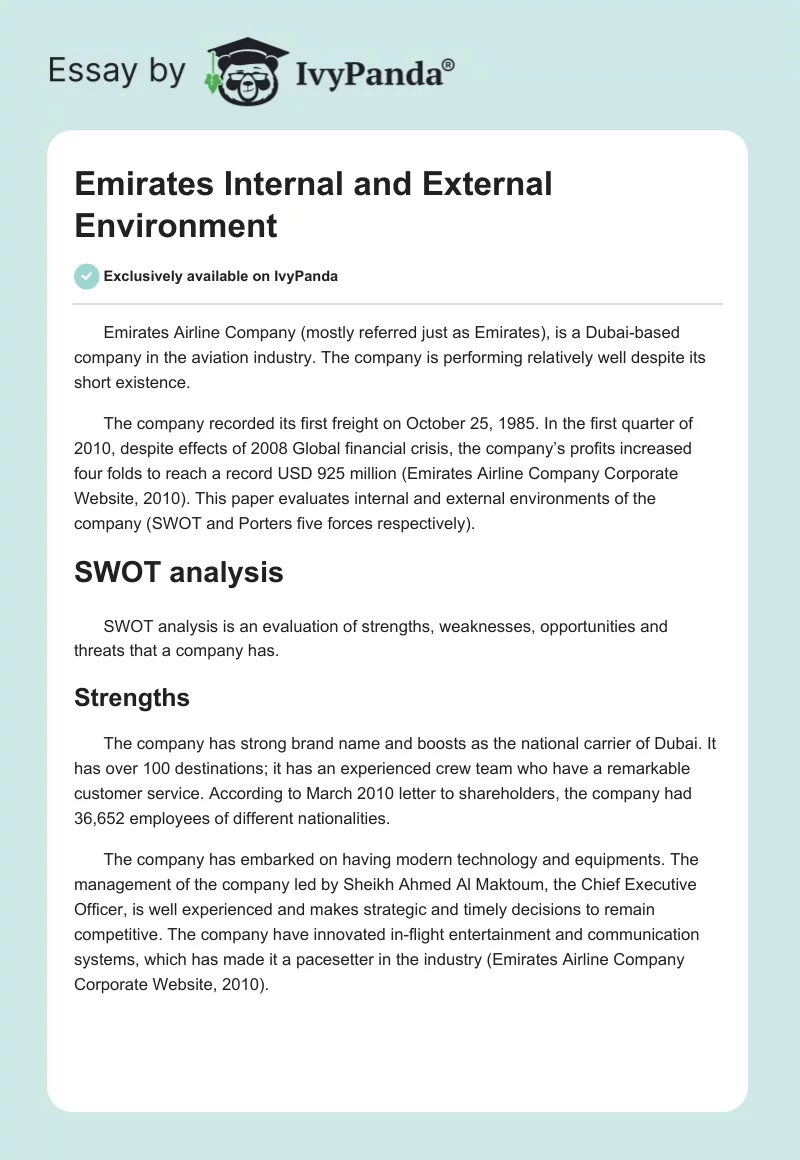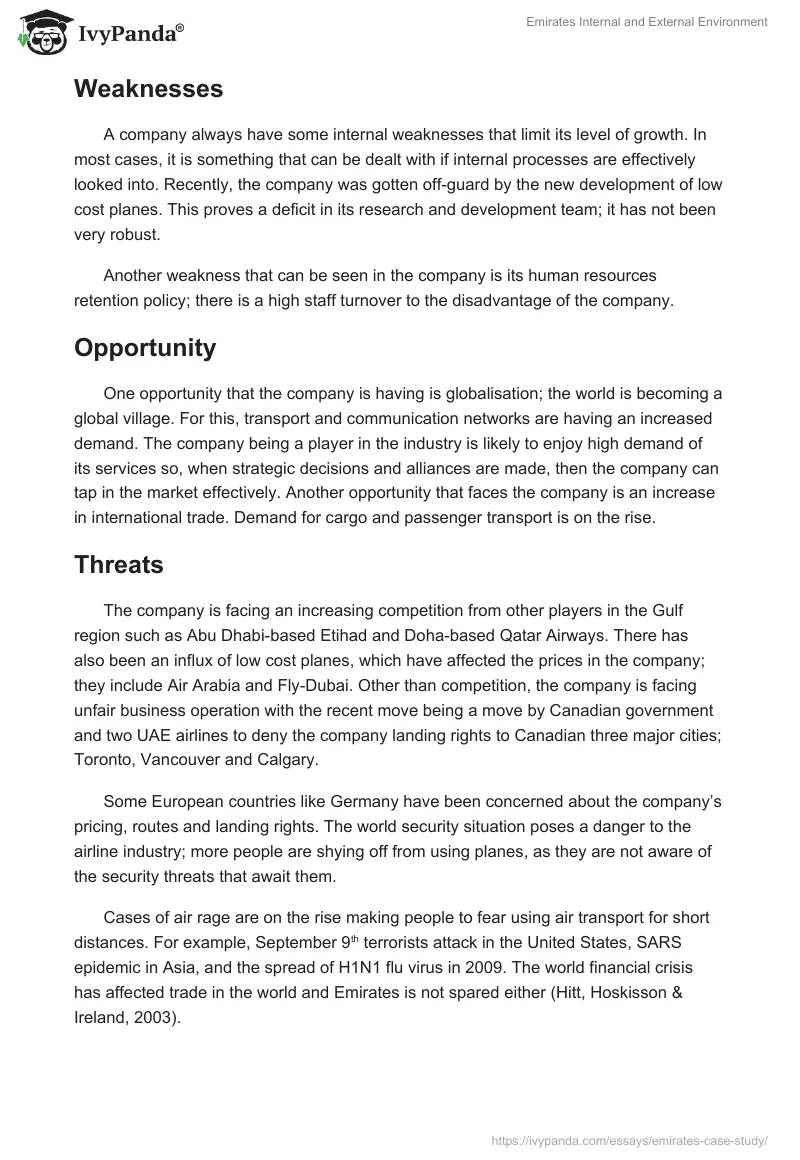Emirates Airline Company (mostly referred just as Emirates), is a Dubai-based company in the aviation industry. The company is performing relatively well despite its short existence.
The company recorded its first freight on October 25, 1985. In the first quarter of 2010, despite effects of 2008 Global financial crisis, the company’s profits increased four folds to reach a record USD 925 million (Emirates Airline Company Corporate Website, 2010). This paper evaluates internal and external environments of the company (SWOT and Porters five forces respectively).
SWOT analysis
SWOT analysis is an evaluation of strengths, weaknesses, opportunities and threats that a company has.
Strengths
The company has strong brand name and boosts as the national carrier of Dubai. It has over 100 destinations; it has an experienced crew team who have a remarkable customer service. According to March 2010 letter to shareholders, the company had 36,652 employees of different nationalities.
The company has embarked on having modern technology and equipments. The management of the company led by Sheikh Ahmed Al Maktoum, the Chief Executive Officer, is well experienced and makes strategic and timely decisions to remain competitive. The company have innovated in-flight entertainment and communication systems, which has made it a pacesetter in the industry (Emirates Airline Company Corporate Website, 2010).
Weaknesses
A company always have some internal weaknesses that limit its level of growth. In most cases, it is something that can be dealt with if internal processes are effectively looked into. Recently, the company was gotten off-guard by the new development of low cost planes. This proves a deficit in its research and development team; it has not been very robust.
Another weakness that can be seen in the company is its human resources retention policy; there is a high staff turnover to the disadvantage of the company.
Opportunity
One opportunity that the company is having is globalisation; the world is becoming a global village. For this, transport and communication networks are having an increased demand. The company being a player in the industry is likely to enjoy high demand of its services so, when strategic decisions and alliances are made, then the company can tap in the market effectively. Another opportunity that faces the company is an increase in international trade. Demand for cargo and passenger transport is on the rise.
Threats
The company is facing an increasing competition from other players in the Gulf region such as Abu Dhabi-based Etihad and Doha-based Qatar Airways. There has also been an influx of low cost planes, which have affected the prices in the company; they include Air Arabia and Fly-Dubai. Other than competition, the company is facing unfair business operation with the recent move being a move by Canadian government and two UAE airlines to deny the company landing rights to Canadian three major cities; Toronto, Vancouver and Calgary.
Some European countries like Germany have been concerned about the company’s pricing, routes and landing rights. The world security situation poses a danger to the airline industry; more people are shying off from using planes, as they are not aware of the security threats that await them.
Cases of air rage are on the rise making people to fear using air transport for short distances. For example, September 9th terrorists attack in the United States, SARS epidemic in Asia, and the spread of H1N1 flu virus in 2009. The world financial crisis has affected trade in the world and Emirates is not spared either (Hitt, Hoskisson & Ireland, 2003).
Porter’s five forces
In 1985, Porter came up with five forces that affect a business. The forces can be used to gauge a company’s competitiveness and its market position. Emirates has been a leader in airline industry, it the national carrier of Dubai, its fives forces are:
Supplier’s power
Emirates depend on different suppliers for various goods and services. Some of these services may be licences and permits offered by different countries allowing the company to land on its airports. The world has embarked on “open air” policy were access to different destination has been facilitated by the use of designated routes.
For the supply of normal operational materials like fuel, uniforms and outsourced services, the company has maintained good relations with its suppliers. It has an integrated supply chain management, which ensures there are commodities when needed.
The main problem that the company is having is entry in some “green” destinations and some European countries. For instance, it has been denied access for political and ideological reasons. One such place is in London Heathrow and Paris Charles de Galle airports, where the company was given second-class degree airports. This limits the company’s growth and operations.
Barrier to entry
Every industry has some barriers to entry that affect a new company negatively. It may be trade secrets, operational costs involved or economies of scale. Emirates has been denied access to some destinations, like in Germany and some countries like Canada has limited the destinations it can land.
This affects the company’s operations negatively. The emergence of low cost planes has created a barrier to entry of domestic market in some countries like the United States of America. This has reduced the competitiveness of the company in such areas.
Threats of substitutes
The aviation industry has high competition and customers have a variety of choices to choose. There are prestigious planes companies that the company has to compete with; the model of the Emirates planes allow for first class, business class and economy on the same plane. However, there are companies offering these classes in individual planes. This gives them a better choice. The industry is facing intensive competition from the entry of low cost planes; they have affected domestic transport more than international transport.
Buyers’ power
Customers are the backbone of a company; the airline industry customers are rational thus they choose a carrier that suits them. This has created some price wars among airline companies a move that have led to reduced business at Emirates.
Rivalry
The airline industry is highly competitive and a small deficiency in a company can led to the company’s failure. Some factors are beyond the control of a company but they affect it negatively. Such factors include world economic performance and technological developments (Hitt, Hoskisson & Ireland, 2003).
Conclusion
Emirate Airline Company is the national carrier of Dubai; it has more than 100 destinations. The success of the company is vested in its experienced management and employees, who make timely strategic decisions. However, the company global growth is affected by world’s economic and political situations and developments in the airline industry. To remain competitive, the company has rolled out a 5-10 operational growth addressing issues that have limited its operations.
References
Emirates Airline Company Corporate Website. (2010).Emirates. Retrieved from https://www.emirates.com/english/.
Hitt, M., Hoskisson, R., & Ireland, K.(2003). Strategic Management: Competitiveness and Globalization. South Western: Thomson Learning.


